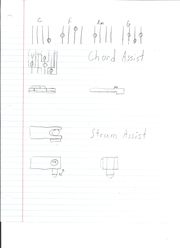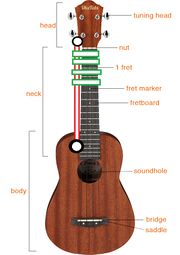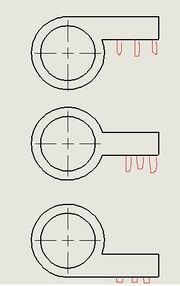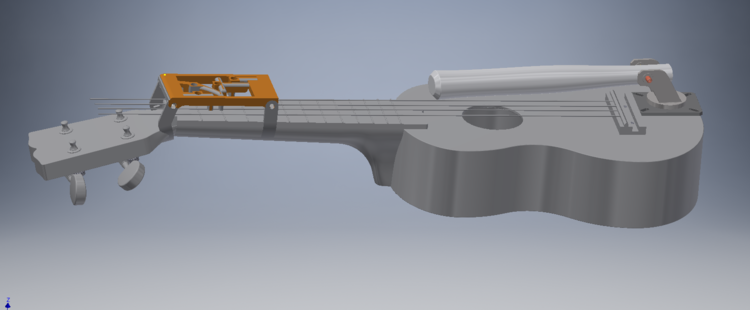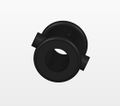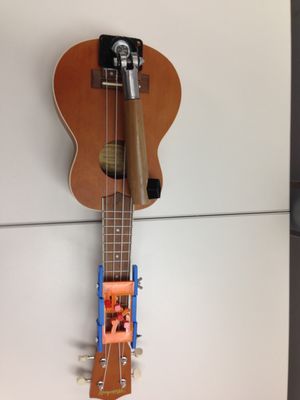Ekulele trainer
Abstract
A young boy with Cerebral Palsy wants to learn how to play the Ukulele with his class next year when he attends 4th grade. He will need to be able to play certain chords and strum the ukulele with certain beats.
Team members
Team IZ
(From Left:Bryon Harrington, Dabney Dickenson, Zack Garner, Tyler Lowe)
Acknowledge help of others
- other
Problem Statement/overview of the need
Summary of the project need
- We are designing an adaptive device for our student with cerebral palsy to assist in fretting and strumming. Below are the three major problems we must consider as design constraints moving forward in the project.
Problem # 1
- Our student has limited mobility and limited fine-motor skills in his left (dominant hand). Because of this, we need to design a device that allows him to form complicated chords without the need to spread his fingers across the fret-board or apply too much force to the frets.
Problem # 2
- The student has no fine-motor skills in his right hand and limited mobility as well. He would be able to preform a strumming motion but we are concerned about the physical fatigue that could be caused by repetitive motion of strumming as well as the students ability to have consistent rhythm without the use of an assistive device of some sort.
Problem # 3
- We may have to rethink the way that the ukulele is played so that the student can play the instrument comfortably. Supporting the guitar neck with his hand may be too physically demanding as well as keeping the guitar strings perpendicular to ground. We may have to consider a rigid structure in a different orientation that would be easier and more comfortable to play.
Design Specifications
The design must be: Low Cost, 3D Printable, Easy to Assemble, Low Profile, Low Weight, Functional, Child Safe, and Nontoxic.
Background research
- There are several products on the market already for a guitar. ChordBuddy and EZ Chord are products that attach to the headstock of a guitar and have several bars with buttons that span the first couple frets of the neck of the guitar. They allow a user to push one button to play a single chord. EZ Fret is a product that attaches to the neck of the guitar with rubber bands that spans 3 frets and lets a user push on a button to hold down a string. The user still has to push multiple buttons to make a single chord. Pick Assists is a handle that has a pick attached to it that helps a person use a pick without having to hold it between their thumb and index finger.
- The main deficiency for the market is there are no products that have been adapted for the Ukulele. This will require changing the design to reflect the number of strings, dimensions and chords. The 4 strings make chords share more finger positions and will require more overlapping to form multiple chords. The smaller dimensions of the Ukulele also makes placing the different parts of the assembly in a position that does not interfere with other parts. Further many of the Ukulele primary chords share finger positions further complicating the assembly. A Ukulele is also played by strumming the string with your thumb. This will require a device to mimic the thumb in order to create the right sound which differs from using a pick as on a guitar.
Conceptual Design
Design Concept 1
- Description
- schematics/pictures/drawings
- estimates on performance/simple calculations if needed
- Similar to the chord buddy, concept one will allow the user to push one button to play a chord. It will be printed as one piece using a material that can flex but will return to its original shape. It will attach to the Ukulele by strap and Velcro or by using a clamp on the head stock just above the nut. The most common 4 chords will be able to be played and if more chords are desired a different configuration can be printed. The user will be able to interchange the different configurations as necessary to play different sets of chords.
- In order to strum the Ukulele for concept one we will design a handle that hold the tip of a stylus. A stylus was chosen as it is designed to mimic a human finger and should produce a similar sound. This is similar to a pick assists used on guitar but replacing the pick with the end of a stylus. This should assist a person who may have trouble manipulating their hand but still can move their arm in rhythm.
- The Chord Assist device should perform well. The normal travel for the fingers will not cause any fatigue to the material. The only concern would be that if one of the fingers was extending beyond its elastic region it would no longer function and the whole assembly would need to be replace. The stylus should produce the same sound as if the ukulele was played with the thumb. There are concerns however that it may wear out faster than a pick due to its hardness when compared to the strings of the Ukulele.
Design Concept 2
- For design concept two, an 8mm smooth rod would be rigidly secured to the head and body, oriented such that it is
orthogonal to the frets. links rigidly attached to 8mm linear bearings forming revolute joints will pivot about the smooth rod. A bar with shafts loaded with springs along the opposite side of the neck will ensure that links do not come into contact with the the strings unless compressed. Applied force on top of the links will cause the ukulele strings to be compressed in a pattern to form chords.
- The links will be planar parts with complex geometries such that they are able to span across many different frets. The planar structures will have different z-positions (distances from the fret board) so that they will be able to overlap each other and activate the same frets independently of each other (because many chords share the same notes). the planes will be attached to a hollow cylinder that we will load with the 8mm linear bearings with a force fir or adhesive.
Design Concept 3
Chord Buddy
Our group has decided to move forward with the adapted Chord Buddy for the Ukulele. Because most songs require the same 4 chords, it would be very effective to program a button on the device for each of the four main chords. This would make moving from chord to chord very smooth and easy for Ben and he would be able to keep up with the class as they learn to play the Ukulele.
Pick Assist
We also decided to move forward with the design of a pick assist that makes strumming the Ukulele as easy as possible seeing as how his right hand has very limited functionality. Connecting him via a wrist strap to the assist would make strumming very simple and not tiring for him.
Detailed Design
Description of selected design
A semi-elastic solid, open plastic rectangle will be printed from flexible filament or PETG (A stronger yet less elastic polymer). flat pieces with extruded pegs will be attached to the interior of the part. the flat pieces will pivot from a point near the head of the ukulele and others from a portion on the neck. The pieces will elastically deform when pressure is applied and fret specific strings in order to form 4 unique chord positions. Two pieces with flexible printed material will support our mechanism such that it does not come in contact with and mute the strings and also act as an elastic band wrapping around the back of the neck. the support pieces/elastic bands will be secured to our mechanism with 2 long bolts and 2 finger-tightened wingnuts.
We plan to also experiment with different methods for securing our part to the ukulele. It is important that the part we create does not interfere with the incorrect frets while other chords are being strummed; it is also important to us that it is relatively easy to remove and adjust for the boy that will use it.
Detailed description of selected design
Analysis
Engineering analysis 1
Click picture to view full image
The image is the bottom of the semi-flexible plate that we will use with our adaptive device.
The long blue lines represent where long bolts will be driven in to the side of the plate and secured to some piece that will be attached to the neck and head of the ukulele. Gray space in the background of the image shows what portion of the plate approximately will be cut out so that the interior portions of the part will be able to move without interfering with the incorrect strings and frets. Small ovals extruded from the bottom of the plate are what will be driven into specific frets to form unique chord positions. The pictured red lines are small cuts taken out of the bottom of the plate; it is our hope that these cuts will cause the interior portions of the plate to revolve about the cuts without significantly compromising material properties and causing the part to deform and break over time. We fear that without cuts the parts will bend around the entire arc and not about the edge of the interior of the plate.
The part was designed such that the extruded ovals line up with specific frets, buttons on the opposite side of the plate have the letter associated with each chord.
We will experiment with different filaments and infill densities and geometries in order to determine what will easily deform elastically without breaking from repetitive motion over an extended period of time.
It will be difficult to determine/calculate the optimal filament type, infill geometry, and infill density without first producing samples with varying infill densities and geometries and then collecting experimental data.
Engineering analysis 2
Click picture to view full image
The above analysis was performed to determine the suitability of use of Thermoplastic Polyurethane(TPU) filament in the Top/Bottom Blackstraps, for attaching the assistive device to the fret board. From this it was determined that the required torque of the m4 bolt was extremely small and the maximum stress in the strap was approximately half of the Ultimate Tensile strength of the TPU. Calculations were performed using data of Elastollan 1154D(TPU) from the below hyperlink
[1]Thermoplastic Polyurethane Elastomers
Engineering analysis 3
Click picture to view full image
The above analysis was performed to determine the degrees of freedom of the motion assist. The DOF was determined to be 2 which is desirable for this application. The motion assist with the associated pick assist allows a user to strum the strings in a predetermined motion. But it also allows the user to return back to the start of the motion without performing an upward strum.
CAD Drawings
Bill of Materials
qty, item, description, source, part number, price
Click picture to view full image
All items found on Amazon.com
Assembly Instructions
Fret Assist
- Install Top bracket in between the first fret and nut.
- Install Lower bracket in between the second and third fret.
- Loosely Install one bolt and wing nut in each bracket.
- Clip fret assist plate onto the bolts.
- Adjust plate so that the G chord 2 end extrusions line up with the second fret.
- Hand tighten wing nuts just enough so the brackets will not move.
Pick Assist
- Peel film from one side of velcro and install on lower bout below the Ukulele bridge.
- Peel film from other side of velcro and Install on the back of the castor
- Attach pick assist to Ukulele by connecting velcro ends.
Fabrication Process
Testing and implementation
We delivered the completed assembly installed on the Ukulele to Dr Shanks the family therapist. She liked the functionality, simplicity and adaptability of the design. Dr Shanks thinks this will meet the need for our student entering 4th grade and will provide feedback to us from the family so we can make the product better.
Photos of Completed design
Instructions for safe use
Do not use the device unless supervised by an adult that has been fully understood the safe use of this product.
Keep fingers clear of pinch areas during operation. Pinch areas include:
- Between Castor, handle and ukulele of the pick assist
- Between the plate and fret board of the ukulele
Project Summary, Reflection
The project turned out as a success due to the great teamwork and feedback from each team member. The product went thru many design changes to make it work. Ultimately it took 3 prototypes of the fret assist to make it work with the final prototype being delivered as the product. The pick assist went from a mock up prototype to a final product that went thru two different handles before making it work. The two products work well together and should allow our student to participate in his 4th grade music class.
The team really shined together and we even made the finals for the Eagle Works innovation competition at Tn Tech, receiving the Social Impact Award. Each of us brought different knowledge and talents that contributed to production of a quality product. Everyone was receptive to feedback which was implemented into the final product. We appreciate the opportunity to help our community and look forward to taking on challenges like this in the future.

